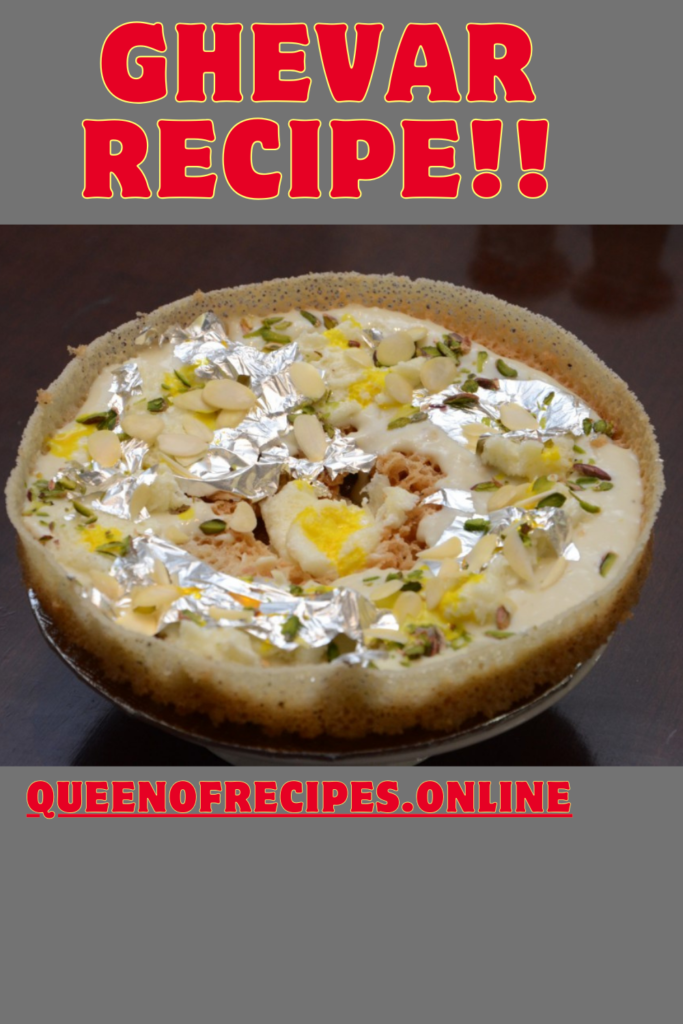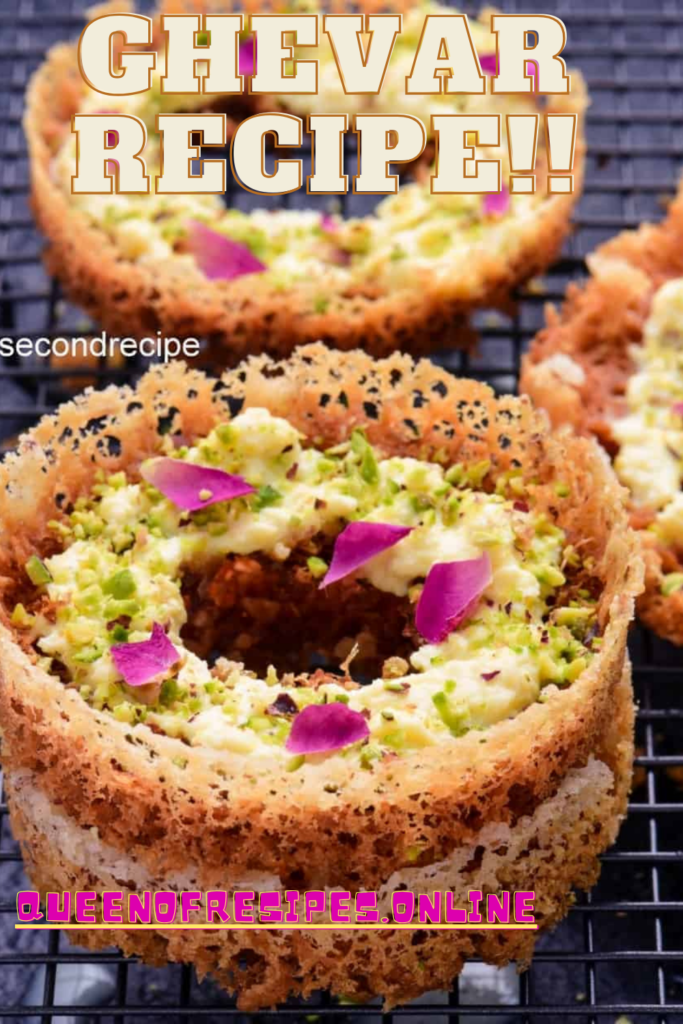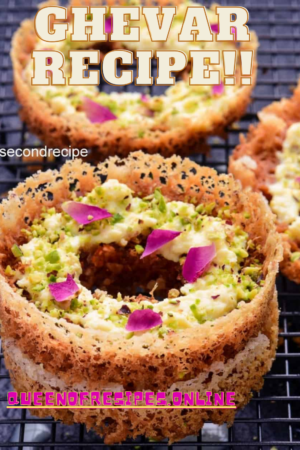Table of Contents
About Ghevar.
Ghevar is a traditional Indian sweet delicacy, particularly popular in the northern regions of India, especially during festive occasions like Teej and Raksha Bandhan. It is known for its unique appearance, featuring a latticed and disc-shaped structure. it is made from a batter primarily composed of all-purpose flour and ghee (clarified butter), which is deep-fried to achieve its crispy and porous texture. Once fried, it is then dipped in a fragrant sugar syrup, which imparts sweetness and moisture to the dessert. It is often garnished with various toppings like chopped nuts, saffron strands, and cardamom. It’s a delightful treat that showcases the rich and intricate culinary traditions of India.
Making it at home requires careful preparation and a few specific techniques. Here’s a basic recipe to help you make this traditional Indian sweet delicacy:
Ingredients:
For the Ghevar:
- 1 cup all-purpose flour (maida)
- 1/4 cup ghee (clarified butter), melted
- 1/2 cup chilled water
- A pinch of baking soda (optional)
- Ice cubes
- Ghee or oil for deep frying
For the Sugar Syrup:
- 1 cup sugar
- 1/2 cup water
- A few saffron strands (optional)
- 1/4 teaspoon cardamom powder
- Chopped nuts for garnish (almonds, pistachios)
Instructions:
Preparing the Ghevar Batter:
- In a mixing bowl, combine the all-purpose flour and a pinch of baking soda, if using.
- Gradually add the chilled water to the flour and mix well to form a smooth, lump-free batter. The consistency should be thinner than pancake batter.
- Add the melted ghee to the batter and mix until well combined.
Frying the Ghevar:
- Heat ghee or oil in a deep, wide pan. The key is to use a pan that is wider rather than deeper, as the Ghevar is flat and requires space to expand.
- To check if the oil is ready, drop a small amount of batter into it. If the batter sinks and then rises to the surface with bubbles, the oil is at the right temperature.
- Place a round, flat-bottomed container (like a steel or aluminum ring mold) at the center of the pan. This container will help shape it as it fries.
- Pour a ladle of the batter into the container gently, ensuring it doesn’t overflow. The batter should form a lacy pattern within the container.
- Once the edges start to turn golden, carefully remove it with a skewer or fork, allowing the excess oil to drain back into the pan.
- Transfer the fried Ghevar to a plate lined with paper towels to remove any additional oil. Repeat the process for the remaining batter.
Making the Sugar Syrup:
- In a separate pan, combine sugar and water to make the sugar syrup.
- Heat the mixture, stirring until the sugar dissolves completely.
- Add saffron strands and cardamom powder to the syrup for flavor and aroma.
- Simmer the syrup for a few minutes until it reaches a one-string consistency. To test this, take a drop of syrup between your thumb and forefinger; when you pull them apart, it should form a single thread.
Assembling the Ghevar:
- Place the fried Ghevar on a serving plate.
- Pour the hot sugar syrup evenly over it. Allow it to soak for a few minutes.
- Garnish with chopped nuts and saffron strands.
- Once the Ghevar has cooled and the syrup has been absorbed, it’s ready to be served.
Enjoy your homemade Ghevar as a sweet and crispy treat, perfect for festive occasions.


Nutritional Value.
Ghevar is a traditional Indian dessert that is rich in calories and sugars due to its ingredients and preparation method. The nutritional value can vary depending on the specific recipe and portion size, but here’s an approximate breakdown for a standard serving of it:
- Calories: 300-400 calories per 100 grams
- Carbohydrates: 50-70 grams
- Sugars: 25-40 grams
- Fat: 10-20 grams
- Protein: 2-4 grams
- Fiber: Minimal
- Vitamins and Minerals: it may contain small amounts of certain vitamins and minerals depending on the ingredients used.
Please note that the actual nutritional content may differ based on the size of the serving, the thickness of it, and the specific ingredients used in the batter and sugar syrup. Ghevar is a high-energy dessert due to its deep-frying and sugar syrup, and it is best enjoyed in moderation, especially during special occasions and festivals.
Health Benefits.
Ghevar, a traditional Indian sweet, is primarily enjoyed for its rich taste and cultural significance during festivals and special occasions. While it’s not typically considered a health food, it does offer some indirect benefits:
- Cultural Significance: It is an integral part of Indian culinary traditions, particularly in the northern regions. It plays a role in cultural celebrations and festivities, fostering a sense of togetherness and community.
- Mood Enhancer: Like many desserts, it can provide a temporary boost in mood and comfort due to its sweet and indulgent nature, making it a source of enjoyment during special occasions.
- Occasional Treat: Enjoying it in moderation as an occasional treat can be part of a balanced diet. Restricting indulgent foods to special occasions can help maintain a healthy eating pattern.
It’s important to consume Ghevar in moderation, as it is typically high in calories, sugars, and fats. While it may not offer direct health benefits, it contributes to cultural and social aspects of life and can bring joy during festive times. Balancing indulgent foods with a nutritious diet is key to maintaining overall health.
Tips and Tricks.
Making Ghevar at home can be a bit challenging due to its unique preparation method. Here are some tips and tricks to help you achieve the best results:
- Use Chilled Ingredients: Make sure the water used in the batter is chilled, and you can even add a few ice cubes to it. Cold batter helps create the characteristic lacy texture of it.
- Ghee Temperature: Ensure the ghee (clarified butter) you add to the batter is melted but not hot. It should be at a lukewarm temperature. Hot ghee can affect the texture of it.
- Frying Temperature: Maintain a consistent frying temperature. Use a wide, shallow pan and keep the heat medium-low. This allows the Ghevar to cook evenly and develop its unique shape.
- Shape and Size: Choose a suitable container for frying. The size and shape of the container will determine the size and appearance of your Ghevar. Use a container with a flat bottom to create a lacy design.
- Lacy Pattern: When pouring the batter into the container for frying, let it flow gently. Do not disturb the batter once it’s in the pan; it will naturally form a lacy pattern.
- Drain Excess Oil: After frying, allow the excess oil to drip off by tilting the Ghevar gently in the pan before transferring it to a plate lined with paper towels.
- Make Sugar Syrup Carefully: Prepare the sugar syrup by dissolving sugar in water and adding saffron or cardamom for flavor. Achieving the right syrup consistency (one-string consistency) is crucial. Be cautious not to overcook, as it can become too thick.
- Hot Syrup: Pour the hot sugar syrup over it while it’s still warm. This helps the syrup to penetrate the Ghevar effectively.
- Cooling: Allow it to cool and soak up the syrup for a few hours before garnishing or serving.
- Garnishing: Garnish it with chopped nuts, saffron strands, or edible silver leaves for an appealing presentation.
- Serve at Room Temperature: It is best enjoyed at room temperature. Serving it too hot can affect the texture and serving it too cold can make it less enjoyable.
It can be a challenging dessert to prepare, but with practice and attention to detail, you can create a delicious and visually appealing treat.


Serviing Suggestions.
Ghevar is a delightful Indian dessert known for its unique texture and sweet flavor. It’s typically served as a special treat during festivals and celebrations. Here are some serving suggestions for it:
- Plain Ghevar: Enjoy Ghevar on its own, savoring its crispy and porous texture. It’s a sweet indulgence that’s perfect for celebrating special occasions.
- Rabri Topping: Serve it with a generous drizzle of rabri, a sweet and creamy condensed milk-based sauce. The combination of the crispy it and rich rabri is heavenly.
- Chopped Nuts: Garnish it with a sprinkle of chopped nuts like almonds and pistachios. These add a delightful crunch and a nutty flavor.
- Saffron Milk: Pour warm saffron-infused milk over it for added fragrance and flavor. Saffron milk complements the sweetness of the dessert.
- Fruit Compote: Accompany it with a fruit compote, such as a cardamom-infused apple or pear compote. The fruity notes contrast beautifully with the sweet Ghevar.
- Ice Cream: Serve a scoop of vanilla or saffron ice cream alongside a piece of it for a modern twist on this traditional dessert.
- Edible Silver Leaves: Decorate it with edible silver leaves (varak) for an elegant and festive touch. This is a common practice during special celebrations.
- Rosewater Syrup: Drizzle a delicate rosewater syrup over it to impart a subtle floral aroma and enhance the overall experience.
- Coffee or Chai: Pair it with a cup of masala chai or strong coffee to balance the sweetness with a hint of spice or bitterness.
- Accompanying Sweets: Serve it alongside other Indian sweets and desserts like jalebi, gulab jamun, or ladoo to create a sweet platter for your guests.
- Customize to Taste: Feel free to experiment with different toppings, syrups, and accompaniments to suit your taste preferences and create a unique Ghevar experience.
It is a versatile dessert that pairs well with a variety of flavors and textures, making it a delightful addition to your festive celebrations.
FAQs.
What are the key ingredients in Ghevar?



The key ingredients in Ghevar, a traditional Indian sweet delicacy, include:
All-Purpose Flour (Maida): It forms the base of the Ghevar batter, giving it structure and texture.
Ghee (Clarified Butter): Ghee adds richness and flavor to it batter, as well as aiding in the formation of the lacy structure.
Water: Chilled water is used to make it batter, and it’s crucial for achieving the desired porous and crispy texture.
Baking Soda (optional): A pinch of baking soda may be added to the batter to enhance the texture, but it’s optional.
Sugar: Sugar is used to prepare the sugar syrup that the fried it is soaked in after frying.
Saffron Strands (optional): Saffron can be added to the sugar syrup for flavor and aroma.
Cardamom Powder: Cardamom is often added to the sugar syrup to provide a fragrant and aromatic element.
Chopped Nuts (e.g., almonds, pistachios): These nuts are commonly used to garnish it, adding a delightful crunch and flavor.
These ingredients come together to create the unique and delicious Ghevar, which is often enjoyed during festive occasions in India.
Can I reheat Ghevar?



Ghevar is traditionally not reheated, as doing so can affect its unique texture and crispiness. It’s best enjoyed fresh, soon after it has been soaked in the sugar syrup and garnished. Reheating it can make it lose its characteristic porous and lacy structure, resulting in a less enjoyable texture.
If you have leftover Ghevar that has gone slightly soft, it’s best to store it in an airtight container at room temperature and consume it within a few days. Attempting to reheat it in an oven or microwave is not recommended, as it may not restore its original texture. It’s best to savor Ghevar when it’s freshly prepared to fully appreciate its unique qualities.
How should Ghevar be stored?



To store Ghevar and maintain its quality, follow these storage guidelines:
Use an Airtight Container: Place it in an airtight container. Ensure that the container is clean and dry to prevent moisture from affecting the texture of the dessert.
Room Temperature: Store the container at room temperature in a cool and dry area, away from direct sunlight and heat sources. Do not refrigerate it, as the moisture in the refrigerator can make it lose its crispiness.
Separate Layers: If you have multiple Ghevar discs or pieces, place parchment paper or wax paper between them to prevent sticking and maintain their integrity.
Consume Promptly: It is best enjoyed fresh and crispy. Consume it within a few days to ensure it retains its unique texture and flavor.
Avoid Moisture: Keep the container tightly sealed to prevent moisture from getting in. Moisture can soften the Ghevar and affect its quality.
By following these storage recommendations, you can enjoy Ghevar for a few days without compromising its crispy and porous texture.
How is Ghevar typically garnished?



Ghevar is traditionally garnished with a variety of ingredients to enhance its flavor and presentation. Here are common garnishes for Ghevar:
Chopped Nuts: Chopped nuts like almonds and pistachios are often sprinkled generously over Ghevar. These nuts not only add a delightful crunch but also contribute to the overall flavor.
Saffron Strands: A few saffron strands may be placed on top of the Ghevar or added to the sugar syrup during preparation. Saffron imparts a lovely aroma and a subtle yellow hue to the dessert.
Cardamom Powder: Cardamom powder is sometimes added to the sugar syrup for its aromatic and fragrant qualities. It complements the sweetness of Ghevar.
Edible Silver Leaves (Varak): Edible silver leaves, also known as varak, are often used to decorate Ghevar, especially during special occasions and festivals. They add an elegant and festive touch.
Rabri: Ghevar can be served with a side of rabri, a sweet condensed milk sauce. Drizzling rabri over the Ghevar adds a creamy and rich element to the dessert.
Rosewater Syrup: A delicate rosewater syrup may be poured over Ghevar to introduce a subtle floral aroma and flavor.
Ice Cream: Some modern variations of Ghevar are served with a scoop of vanilla or saffron ice cream, creating a delightful combination of textures and temperatures.
Fruit Compote: Ghevar can be paired with a fruit compote made with fruits like apples or pears, cooked with cardamom and sugar for a fruity contrast.
These garnishes not only enhance the visual appeal of Ghevar but also add layers of flavor and texture, making it a delightful and indulgent dessert. The choice of garnishes may vary based on regional preferences and personal taste.

